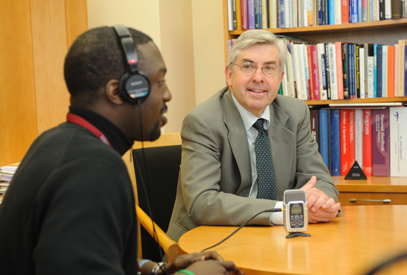With the number of annual strokes now reaching
780,000, there is an even greater need for public education about the symptoms and the urgency of seeking treatment for stroke. In recognition of May as National Stroke Awareness
month, NINDS conducted several outreach
activities:
Radio. NINDS deputy director Dr. Walter Koroshetz and Dr. John Lynch, a program director in the NINDS Office of Minority Health and Research, conducted a radio media tour and gave interviews to radio networks and stations across the country, from Sarasota, Fla., to Dayton,
Ohio, and the national affiliate American Urban Radio Network. The total estimated audience
was 1.5 million listeners. Koroshetz also was interviewed by NIH Radio for a feature on stroke that aired on 1,000 stations through XM Radio and is available on the NIH web site.
NIH Podcast. Lynch was interviewed by Dr. Vivian
Pinn, director of the NIH Office of Research on Women’s Health, for the podcast “Pinn Point on Women’s Health: Women and Strokes.” The program is available on the NIH web site and has an average of 300 downloads a week.
English and Spanish print releases. NINDS releases, which were each geared to general, African-American and Hispanic audiences, were distributed to networks of more than 10,000 national and community newspapers, 500 African-
American-focused newspapers and more than 700 Hispanic-focused newspapers.
 |
| NINDS deputy director Dr. Walter Koroshetz (r) is interviewed by NIH Radio’s Woleola Akinso for a feature on stroke. The program aired on 1,000 stations through XM Radio. |
Spanish-language radio release. NINDS scripted,
produced and distributed a Spanish-language
radio release to 500 Hispanic stations, including community and public outlets across the U.S. In addition to raising awareness about
NINDS deputy director Dr. Walter Koroshetz (r) is interviewed by NIH Radio’s Woleola Akinso for a feature on stroke. The program aired on 1,000 stations through XM Radio.stroke symptoms, the 60-second release highlights
the need for non-English speakers to say “stroke” when calling 911.
NINDS has been building on its national public education campaign, Know Stroke: Know the Signs. Act in Time with the critical messages that stroke is an emergency and that bystanders
and stroke patients alike must be able to recognize the symptoms and act quickly. The campaign offers a wide array of public and professional
educational materials on stroke symptoms,
prevention, treatment, research and rehabilitation,
which can all be found on the new web site www.stroke.ninds.nih.gov/. The institute
has also launched a grass-roots stroke education
program, Know Stroke in the Community,
and has identified local “Stroke Champions” in 11 cities to date.
NINDS also reached out to its partner organizations
to take part in Stroke Month activities. The General Federation of Women’s Clubs, the world’s oldest and largest women’s community service organization, placed a Know Stroke feature
on its web site. The National Council of La Raza promoted the NINDS Spanish-language toolkit for promotores (lay health educators) in its affiliate member services e-newsletter in May. The messages reached health educators in more than 300 Hispanic community-based clinics
and organizations, with information on how to order and use the toolkits.
President George H.W. Bush declared May National Stroke Awareness Month in 1989 to enhance public awareness of stroke. 